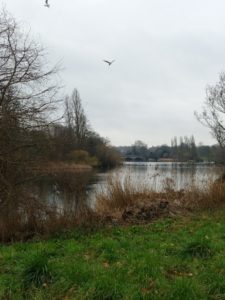
During the Regency, going to the park wasn't just for children; gentlemen and ladies of fashion frequented the parks in London to ride, walk, and make a fashion a statement. Regency ladies and gentlemen often chose Hyde Park as a favorite place to ride on horseback to get some fresh air and exercise. However, it was most popular as a place to drive in open carriages to show off clothing, or the latest rig, or horses. It was THE place to see and be seen.
 |
| Hyde Park section of "Improved map of London for 1833, from Actual Survey. Engraved by W. Schmollinger, 27 Goswell Terrace"[/caption] |
The Ton, or members of the 2,000 aristocratic families at the height of English society, as well as a few social climbers trying to fit in, promenaded at Hyde Park, peacocking and flirting with others drawn to the park to take part in the social rituals.
 A brick wall enclosed Hyde Park in 1660 at the order of James Hamilton, the Keeper of the Park under Charles II. The avenue fashionable for disporting oneself in Georgian Times was Rotten Row. The name Rotten Row is believed to be a corruption of La Route du Roi, or King's Road, which was its original name. Another likely possibility as to the name comes from the materials of the road made of a mix of gravel and crushed tree bark to create a firm, yet pliable surface. Some definitions of "rotten" are "friable," "soft" or "yielding" which describes the surface ideal for horses' feet and legs. Think of the tracks which runners use, firm yet slightly springy--perfect for running without causing undue strain on athletes' bones, muscles, and tendons.
A brick wall enclosed Hyde Park in 1660 at the order of James Hamilton, the Keeper of the Park under Charles II. The avenue fashionable for disporting oneself in Georgian Times was Rotten Row. The name Rotten Row is believed to be a corruption of La Route du Roi, or King's Road, which was its original name. Another likely possibility as to the name comes from the materials of the road made of a mix of gravel and crushed tree bark to create a firm, yet pliable surface. Some definitions of "rotten" are "friable," "soft" or "yielding" which describes the surface ideal for horses' feet and legs. Think of the tracks which runners use, firm yet slightly springy--perfect for running without causing undue strain on athletes' bones, muscles, and tendons.Recently, I heard another possible explanation for the name: Rotten Row led to Eton College, and since French was commonly spoken among the aristocracy then, they called it Rue d'Eton - easily corrupted into Rotten. That doesn't explain how Row came into use, however.
Regardless of its origin, on Rotten Row a Regency lady or gentleman could flirt, greet friends, and show off beautiful driving clothes and equipage or mount. Gentlemen wearing the ankle length drab coat and yellow striped blue waistcoat of the Four-in-Hand club were sprinkled in the passing cavalcade.
Carriages bearing the painted and gilded family crests of the Ton and the living ornament of a Dalmatian coach dog and liveried servants glide by in spotless splendor. The pair of footmen riding at the back of the coaches are as well matched as the teams of horses in their coloring and six-foot or better height. Among the carriages are those of courtesans bearing faux crests meant to remind them of the crests of their titled lovers.
C. J. Apperley writes of the fashionable hour in Hyde Park, "on any fine afternoon in the height of the London season…he will see a thousand well-appointed equipages pass before him…Everything he sees is peculiar, the silent roll and easy motion of the London-built carriage, the style of the coachmen - it is hard to determine which shine brightest, the lace on their clothes, their own round faces, or flaxen wigs - the pipe-clayed reins - pipe-clayed lest they should spoil the clean white gloves…not forgetting the "spotted coach-dog, which has been washed for the occasion…such a blaze of splendor…is now to be seen nowhere but in London."
The movie An Ideal Husband shows a scene of a Victorian drive in Hyde Park, and many of my heroes and heroines go driving or riding in Hyde Park.
The last time I was in England (February 2019), I spent a few hours in this lovely park. Though I didn't see any carriages, this park serves as a quiet haven from the bustling city where people of all ages stroll, dogs run and play, and children scamper. It may not be as fashionable as it once was, but it still plays a vital role in the city.

Sources:
Bellamy, Joyce, Hyde Park for Horsemanship. London: J.A. Allen, 1975
https://regencyredingote.wordpress.com/2009/08/07/rotten-row-was-rotten-kinda/
https://en.wikipedia.org/wiki/Rotten_Row
And the many careful researchers and fellow history geeks at the Beau Monde chapter of RWA.








No comments:
Post a Comment